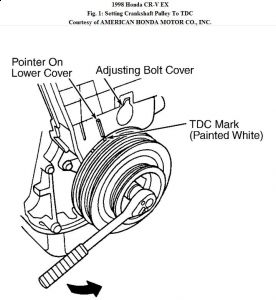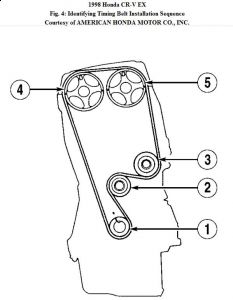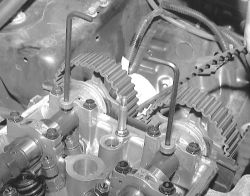Hi Tony,
No special alignment tools are required for the CRV engine.
Here is a diagram of the timing marks that should line up when the belt is correctly installed.



Installation
1 . Ensure No. 1 cylinder is at TDC of compression stroke. Timing belt drive pulley TDC mark must align with pointer on oil pump housing. See Fig. 3 .
2 . Set intake and exhaust camshaft pulleys to TDC. The TDC marks should align with cylinder head surface with "UP" marks pointing up. See Fig. 3 .
3 . Install timing belt in this sequence: timing belt drive pulley, tension adjusting pulley, water pump pulley, exhaust camshaft pulley, and intake camshaft pulley. See Fig. 4 . DO NOT bend or twist belt excessively. Ensure arrow on used belt points in original rotation direction. Check that crankshaft and camshaft pulleys remained aligned with TDC marks.
4 . Loosen and retighten adjusting bolt to tension timing belt. Install lower and middle covers. Install crankshaft pulley. Tighten pulley bolt to specification. See TORQUE SPECIFICATIONS . Rotate crankshaft pulley 5 -6 turns counterclockwise so timing belt positions on pulley.
CAUTION: Always adjust timing belt tension with engine cold.
5 . To adjust timing belt tension, set No. 1 piston at TDC (White TDC mark on crankshaft pulley aligned with pointer on cover). See Fig. 1 . Loosen adjusting bolt 180 degrees. Rotate crankshaft counterclockwise 3 teeth on camshaft pulley. Tighten adjusting bolt. If necessary, retorque crankshaft pulley bolt.
6 . Ensure crankshaft and camshaft pulleys are still aligned at TDC. If not, timing belt will need to be removed and repositioned.
7 . To complete installation, reverse removal procedure. When installing cylinder head cover gasket, apply liquid gasket (Part No. 08718 - 0001 or -0003) to 8 corners where gasket meets camshafts. Tighten fasteners to specification. See TORQUE SPECIFICATIONS . Adjust drive belts to proper tension.
If your rear differential fluid had not been replaced for quite some time, do so and see if the problem is resolved.
Saturday, November 28th, 2009 AT 5:42 AM






